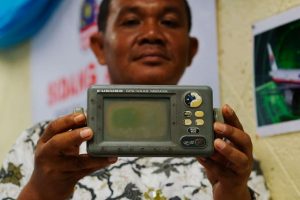JANUARY 31, 2019

A new study suggests Malaysia Airlines flight MH370 took a different route on the day it disappeared and crashed north-east of Madagascar, not south-west of Western Australia.
Scientists at Cardiff University have been studying underwater sound waves recorded on the day the flight disappeared.
If the data is from the missing aircraft, it would indicate it crashed much further north than the area already covered by a lengthy and expensive search.
Flight MH370, carrying 239 people, disappeared as it made its way from Kuala Lumpur to Beijing on March 8, 2014.
 (Provided by Daily Mail) Grace Subathirai Nathan, (R) daughter of missing Malaysia Airlines flight MH370 passenger Anne Daisy and MH370 #SearchOn Campaign leader pictured with Malaysia’s Transport Minister Anthony Loke Siew Fook (EPA)
(Provided by Daily Mail) Grace Subathirai Nathan, (R) daughter of missing Malaysia Airlines flight MH370 passenger Anne Daisy and MH370 #SearchOn Campaign leader pictured with Malaysia’s Transport Minister Anthony Loke Siew Fook (EPA)
Two hydro acoustic stations in the Indian Ocean – one off Cape Leeuwin in Western Australia and the other in north-west at Diego Garcia – have picked up acoustic-gravity waves which are being examined by the scientists.
 Rusli Khusmin, 42, a fisherman from Indonesia shows his GPS Navigator which he used to record the co-ordinates of where he believes Malaysia Airlines Flight MH370 crashed – Getty
Rusli Khusmin, 42, a fisherman from Indonesia shows his GPS Navigator which he used to record the co-ordinates of where he believes Malaysia Airlines Flight MH370 crashed – Getty
Each of the two stations continuously record soundwaves in the oceans.
Signals from both indicate waves that could have come from a large object, such as a meteorite or an aircraft hitting the water.
Previous studies by both Cardiff University and Western Australia’s Curtin University have looked at signals from the Cape Leeuwin station between 12am and 2am UTC on March 8, 2014, when the plane is believed to have crashed based on the aircraft’s satellite data.
 Grace Subathirai Nathan (R), daughter of Malaysian Airlines flight MH370 passenger Anne Daisy, shows a piece of debris believed to be from flight MH370 (AFP/Getty Images)
Grace Subathirai Nathan (R), daughter of Malaysian Airlines flight MH370 passenger Anne Daisy, shows a piece of debris believed to be from flight MH370 (AFP/Getty Images)
But, the researchers at Cardiff University were prompted to examine signals from Diego Garcia and look at a wider time frame – from 11pm on March 7, 2014 and 4am the next day – by a new understanding of how fast and far the waves travel underwater.
“We have now been able to identify two locations where the aeroplane could have impacted with the ocean, as well as an alternative route that the plane may have taken,” Cardiff University’s Dr. Usama Kadri wrote on The Conversation.
If the signals picked up by the Diego Garcia are from the missing aircraft, it would indicate the doomed plane took a different route to the one that has been long assumed.
The new data from Diego Garcia would point to a crash site “in the northern part of the Indian Ocean,” north-east of Madagascar, Dr. Kadri said.
Two searches of the presumed crash site south-west of Western Australia have failed to turn up any trace of the plane.
Later, pieces of the aircraft began washing up off the coast of Africa with the latest find appearing on a beach in Madagascar.
Dr Kadri said it is possible the the sound signals from the northern hydroacoustic station were distorted by “noise” that could have been caused by a military exercise, known to have been in place around the time on that side of the Indian Ocean.
He said it is feasible that these large soundwaves may instead have come from a rocket or missile being fired, rather than a Boeing 777 crashing into the ocean.
 Malaysians look at the Malaysia Airlines flight MH370 mural painting at Shah Alam, outside Kuala Lumpur (EPA)
Malaysians look at the Malaysia Airlines flight MH370 mural painting at Shah Alam, outside Kuala Lumpur (EPA)
Inexplicably, Dr. Kadri said that there is 25 minutes of data missing from the Diego Garcia station, where the US has a secretive military base.
Dr. Kadri is calling for further independent research of the wider time frame identified by the researchers.
He has made his recommendations to the two the Australian and Malaysian bodies who oversaw the previous searches the hope a new search will resume to find the missing aircraft.
The Cardiff research team also plans to carry out a series of field experiments to see if they can extract more information from the data picked up by the two hydro acoustic stations.
Courtesy/Source: Evening Standard










































































































